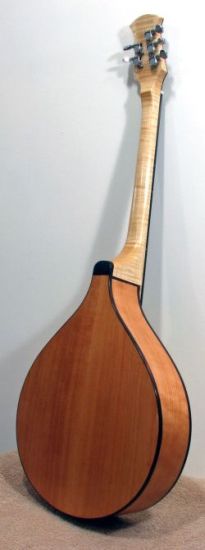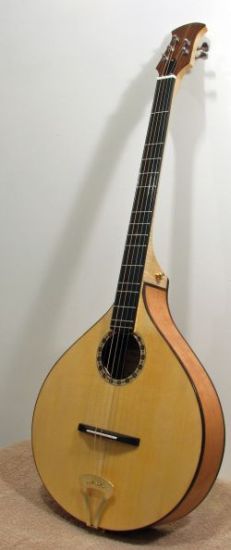In ancient Greece, a chimera was a mythological creature made up of parts of three different animals. By analogy, i have chosen the name chimera to apply to the instrument that i designed which has characteristics of three different instruments: It has a bouzouki body, a (diatonic) dulcimer fretboard, and five strings, with a high pitched fifth string like a banjo (except the fifth string is full length).

 My instrument, which i have specifically named “Chimera” (same as the generic class name) was made by luthier Stan Pope of British Columbia. It has a Sitka spruce top, cherry back and sides, and maple neck. I refinished it myself with shellac using a French polish technique.
My instrument, which i have specifically named “Chimera” (same as the generic class name) was made by luthier Stan Pope of British Columbia. It has a Sitka spruce top, cherry back and sides, and maple neck. I refinished it myself with shellac using a French polish technique.
Strings 1-5 are tuned, respectively, d g D G g’ , where G is the note that one gets from the sixth string of a standardly tuned guitar when fretted at the third fret; g is an octave higher than G and g’ two octaves higher than G. D is the same pitch as the open fourth string of a standardly tuned guitar, and d is an octave higher than D. This tuning means that, when not capoed, Chimera is set to play in the key of G. It can be capoed to play in the keys of A, C, and D as well.
With this tuning, a two octave scale can be played within the first three frets of the first four strings. Moreover, the third fret is needed only for the 4th note (C in the case of the key of G) on strings 2 and 4. (If needed, notes higher than the two octaves can be reached using higher frets on the first string.) This regularity means that a chimera is very easily played by ear in its chosen keys. While a guitar can be played in any key, the notes fall irregularly on the fretboard, requiring considerably more memorization of the note locations.
In playing, i use mainly the first three strings for melodies, and the fourth and fifth strings (and occasionally the third) to provide bass accompaniment in the form of drones or grace notes. You can get a sense of this approach here.